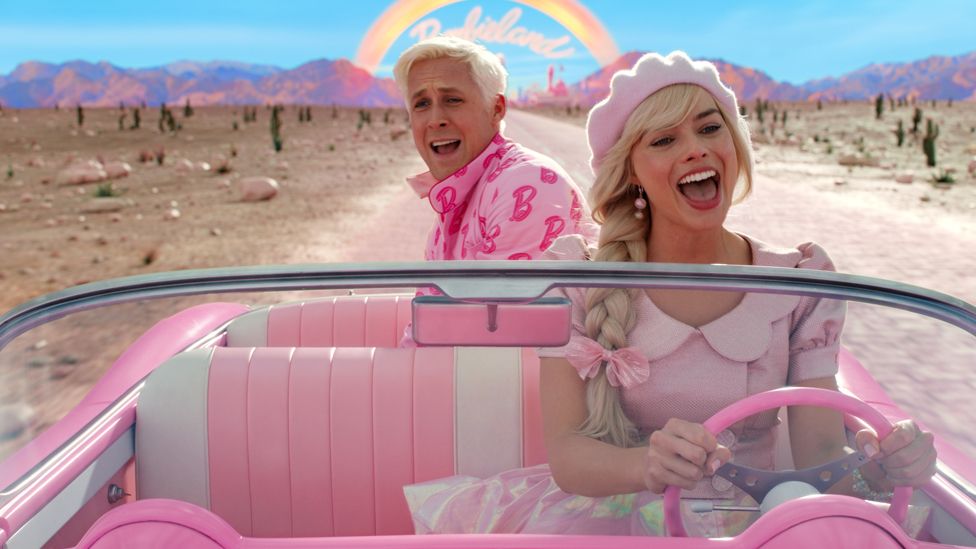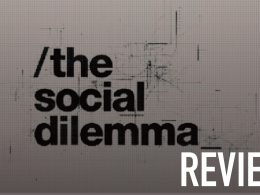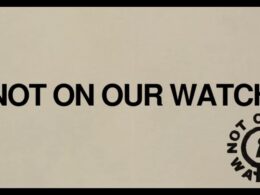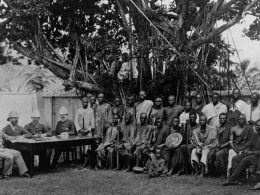By Celina Brandstötter, Sarah Moayeri, Roberta F.
The blockbuster Barbie film currently showing in theatres breaks numerous records at the box office and is hotly debated everywhere. It earned $1 billion after just 17 days, making Greta Gerwig the first woman solo director to reach such a record. Above all, many women and queer people find themselves reflected in the problematic experiences lived by the characters in the film. Conservatives and members of the right-wing, particularly in the US, declare the film to be leftist, “woke” propaganda. Whilst within anti-capitalist left-wing circles, the film is mostly ridiculed: “Where is the criticism of capitalism here?!” they say. Mattel has indeed cleverly succeeded in ranking in record profits with the film and the accompanying merchandise. A big image change out of pure profit interest.
Corporations like Mattel have no interest in real emancipation of women and queer people. They try to profit from everything, including the new feminist wave. However, we find that the film contains numerous positive elements and that the widespread enthusiasm for it should not be simply dismissed.
“This Barbie tells you about the patriarchy”
The film sarcastically shows Barbie’s shock when confronted with the real world outside of “Barbieland”. To Barbie’s confusion, the real world is a patriarchal society dominated by rampant everyday sexual harassment, sexism, sexualization and objectification of human bodies. As it is so beautifully said in the film: “It is impossible to be a woman” — In other words, impossible to meet all expectations.
In the start of her journey, she very excitingly spreads the female solidarity she is used to in Barbieland. She tells women how beautiful they are and tries to empower them; yet, she quickly realises how the iconic Barbie doll has failed in bringing the fantasy to real life. The mentality switch has failed to represent itself in the institutions. The great promise of feminism in recent decades doesn’t seem to have taken hold. Barbie is unsure of how this could have happened; after all, thanks to Barbie, women today “can be anything”…. can they not?
On the contrary, tagging along on Barbie’s mission, Ken, as a white good-looking cis man, is astounded by the Patriarchy and proceeds to learn about it. In the course of the film, the eternally rejected Ken decides to bring “the patriarchy” to “Barbieland” and, whilst Barbie is trying to fix things in the real world, Ken proceeds to convince all Barbies in Barbieland to ditch their high-flying careers, and their girls nights, and to instead focus on spending their time serving and supporting the creation and growth of the newly established Patriarchy in Barbieland.
Nonetheless, with the help of a real-world mother-daughter duo, Barbie manages to revert the order and understand what led the Kens to revolt. The Kens lived in a world where they only existed in the orbit of Barbie. They are redeemed at the end when they are freed through Barbie’s encouragement to go find themselves. Barbie apologises admitting that “less nights could have been only girls’ nights ”.
With ironic humour, the film manages to refer to the everyday experiences of many women and queer people living under capitalism. In view of a very male-dominated film world, in which women are often only ‘exhibited’ as objects of the men-gaze, it is not surprising that many women feel attracted to this film that wittingly creates a dystopian world in which the roles are reversed. The enthusiasm around the film expresses a widespread desire among many women and queer people that the reality of their lives actually be perceived in the culture industry. For a long time, this very form of perception and representation hardly took place in mainstream cinema, but now major film companies are increasingly taking up these issues. Feminism should be viewed as a political movement in dialogue with the thinking of its time. In broader mainstream culture the film is also addressed at anti-feminists. Those who, regardless of the very real failures of the patriarchy, insist on maintaining the status quo. And it does so by appealing to empathy, saying that if men manage to understand and truly comprehend the feelings, experiences, and oppression of women and queer people, they will be able to truly comprehend the damages that the patriarchy does to us all and hopefully join the struggle in solidarity.
The reappropriation of the colour pink and “all things girly” is very well achieved in the film and speaks to many from the soul. Even the hostile teenager dressed in all black, by the end of the film is wearing pink. Far from having a negative connotation, these symbols come to represent empowerment for women and girls in the film. Therefore, countering the sexist argument that denies girls and non-binary people the freedom to make their own decisions. We have witnessed waves of sexism anti-feminism propaganda as a response to the film online. Among the many taglines and posts on the various social media platforms, one that popped out for us was “to understand Oppenheimer you need to have a knowledge of physics, psychology, warfare, history and culture… to see Barbie you need to be woke.” Barbie has proven to be a controversial movie that has had the capacity to ignite and bring to the surface the negative bias towards everything that is perceived as “feminine”. How deeply entrenched sexism actually is can be seen here.
However, the reception of the film and the polarization also point to changing gender roles in the consciousness of broad masses, to which even large film companies such as Warner Bros. or Barbie company Mattel are adapting. Companies that even until a few years ago earned billions in profits from the dissemination of toxic gender roles and now engage in “pink-washing.” They are trying to market this feminism. This triggers different things in us: We are happy that the reality of our lives finds a place on the screen. Cultural representation is an important step to influence the necessary mindset change. But we are also angry about this pinkwashing. After all, these are our struggles, they are struggles from below. The fact that feminist ideas are now represented in mainstream media and big companies are using them is related to the effect of huge feminist protest waves. The last few years have been marked by numerous feminist struggles, from Latin America to Poland, from South Korea to Iran: struggles for abortion rights, against violence and femicide, for LGBTQIA+ rights, against sexual assault, and much more. This new feminist wave expresses a trend of radicalization against patriarchal conditions. These radical changes politicize not only young people, but broader layers worldwide. Therefore, the great enthusiasm for the film, which many see as an expression of their daily experiences with sexism, is not surprising. It shows that although much has changed in people’s consciousness and attitudes, the real social conditions do not reflect this radical change.
The “Manosphere”: the anti-feminist backlash
But the film also appeared at a time of deep polarization. It is not surprising that the conservative right and the “Manosphere”, especially in the US, see in this “woke” Barbie an enemy. That a fictional film can already trigger so much outrage and fear among conservatives and the right-wing shows how little “woke” capitalism is actually “allowed” to be. Even the quite limited feminism that is at the center of the film — women should be more at the top of companies and governments, should live on an equal basis with men and should be able to express themselves freely — is increasingly under attack.
The right-wing propaganda against the film can be linked to the steadily growing right-wing conservative movement. It is not only in the US that there is a pushback against expansion of the traditional gender binary but also in Europe where a conscious effort to maintain gender as a binary concept and the “traditional” family can be witnessed. On the internet, at demonstrations and beyond right-wing mainstream politics is trying to maintain the traditional gender binary. The devastating consequences can be seen in the attacks on abortion rights, queer rights, trans rights and rights of women and queer workers and the working class in general.
This anti-feminist backlash, especially against the LGBTQIA+ community, can be explained by the fear of the ruling class that these movements and sentiments might be strongly shaking the patriarchal status quo. However, it would be simplistic to excuse this anti-feminist reactions to the film simply to the “offended male egos”. As socialist feminists, we see the patriarchal system as a necessary element of capitalism that serves to sustain it. This system is expressed, among other things, in the structures of the family, in underpaid care work and the exploitation of reproductive work or work as women’s third burden. The violent resurgence of ultra-conservative, bourgeois gender ideas can be linked to the general crisis of capitalism, in which feminist achievements have to be withdrawn. Those bourgeois-conservative gender norms are ultimately not just a “cultural phenomenon” but have an economic basis that is expressed on a socio-cultural level. The global capitalist system is currently in a deep crisis. This crisis is expressed in large issues such as widening inequalities, climate change, war, but also in economic low flights and the opacity of supply chains in all necessary products such as food or textiles. This state of crisis makes it necessary to withdraw hard-won feminist concessions in order to secure the economic gains of the capitalist class.
“Where is working-class Barbie?!”
Of course, there is no criticism of capitalism in the film, let alone linking patriarchy, to it. There is no mention of money and profit in the entire film. Barbie does all the jobs, there is Barbie Astronaut, Barbie President, Barbie construction worker, but what are they working for? Are they receiving salaries? Or are they simply working for the good of Barbieland? But this question is not answered in the film — it seems rather as if the contradictions of capitalism, which also seems to exist in Barbieland, have magically disappeared.
Same goes for the real-world example. The teen-mother duo can just take off for who knows how long, skipping work and school, with their very nice car. The men in the Barbie’s board of trustees seem to be purely dedicated to the cause of maintaining the patriarchy, whilst one might argue that the reason for them to want to maintain the status quo is the economic profit and power that it ensures them. Even the man who works in the cubicle who breaks the news of Barbie’s escape to the powerful bosses, should be bitter in realising that him, and many others, are being exploited for the profit and welfare of very few people. On the contrary, he joins them in the quest to bring Barbie back to Barbieland and is seemingly blind to the mockery and sarcastic judgement he receives throughout by his superiors.
The fact that the question of feminism has a central economic core remains hidden in other aspects. Where is the single mother Barbie who has to make ends meet with three jobs? Where is Nurse Barbie struggling with low wages, staff shortages and burnout? Where are the PoC Barbies who struggle with racism and sexism on a daily basis? Ignoring the capitalist system that has given light to the patriarchy, seeing men as the only breadwinners, and using unpaid care work to sustain it, seems very convenient for a film that is trying to bring back its sales of Barbie dolls and tap into a new customer base.
The Kens can introduce a patriarchy in Barbieland overnight, thereby presenting it as something “made up” by men who, by the way, in Barbieland are bearable only because they are subjugated to Barbie, and in the real world are depicted as stupid, incapable and offensive. How can such submitted or stupid creatures have created such a complicatedly oppressive system? A system that has very real and damaging effects, as seen in the scene where Barbie gets slapped on the ass in the street, a system that kills women everywhere every day? Blaming it all on the hurt male ego, and the weakness of masculinity, seems to be the only way that the film is able to create this fantasy without mentioning the way more oppressive capitalist system.
The fact that the patriarchy ultimately only promises men things that it cannot keep and only gives an illusion of “power” is nonetheless addressed in the film, including in the hyped “I’m just Ken” song. Ken is one of the most compelling characters in the movie. He is constantly broken by his own demands, is extremely vulnerable and also lonely. This confrontation with masculinity opens up a lot of space and visibility for a discussion about why overcoming patriarchal role models and structures is also in the interests of men. Some of the strongest scenes in the film are where we see men cry, showing they can be weak. Considering that Barbie does not mock that behaviour, who are men being “machos” for? There is also no place for alternative ideas of masculinity, such as the one represented by Alan. This is also evident in the fact that the character of Alan, who is mocked by men and women, Kens and Barbies, tries to escape but ends up stuck in Barbieland, unredeemed.
That “Barbie” has a working-class connection is, of course, hardly to be expected. However, the fact that almost any connections beyond the cultural level of role models and sexism are left out gives the impression that patriarchy is only a question of cultural attitudes. The struggle for liberation from toxic gender roles, sexism, and other manifestations of deeply patriarchal social structures and culture is inextricably and inevitably linked to the struggle against capitalism. These struggles are mutually dependent. A “feminist choice” cannot be the solution to achieving comprehensive rights for vulnerable and oppressed groups.
The Barbies’ “solution” in the film is to psychoanalyse the “Kens” and let them free to discover who they are in this Barbieland. Yet, the Hollywood film does not address the fact that women in part-time work or in low-wage industries cannot simply decide against their oppression. Structural problems of female and queer working-class people cannot be solved by more education alone, even if a feminist consciousness is extremely important for this struggle, it should not be the individual’s struggle alone. The Barbies create an “aha” effect by talking about the structural oppression they experience in the newly established patriarchy. They make it visible and spread the message that this is not a life worth living, not a free choice. They open the Barbies’ eyes. The film manages very well to show how much value that actually is. To see and understand what one’s oppression means. That we are not alone with catcalling, men who want to explain the world to us, sexism and violence. This “aha” effect has already begun in reality for very many people and is increasingly expressed in struggles for this very reason: So just realizing it is not enough.
Even though the film is capitalism-blind, it is an achievement for such a narrative to make into the mainstream pop culture. A great many women and queers have celebrated the cinema experience alone as an environment where it’s okay to wear pink and not be judged for it. In which it’s okay to think Barbie is cool and a reminder of childhood memories. Something many of us were mocked for as little kids. Many of us have seen this cinematic experience as a small moment of empowerment, mutual solidarity and sisterhood — an element that also appears again and again in the film, for example when Barbie tells an older woman in the real world on the street, wearing a sparkling pink hair band, how beautiful she is. We want to fight for a world in which this feeling is omnipresent, in which we can live without fear and live our lives to the full — away from gender and beauty norms, exploitation and oppression. In the end, despite the adversities of the real world, Barbie realises that her work is done in Barbie Land, whilst the fight in the real world isn’t over and she needs to be a part of it. She decides to be human. We fight against real, unbearable conditions, against daily violence and the threats to our lives posed by sexism, racism and capitalism — because we have no other choice.












